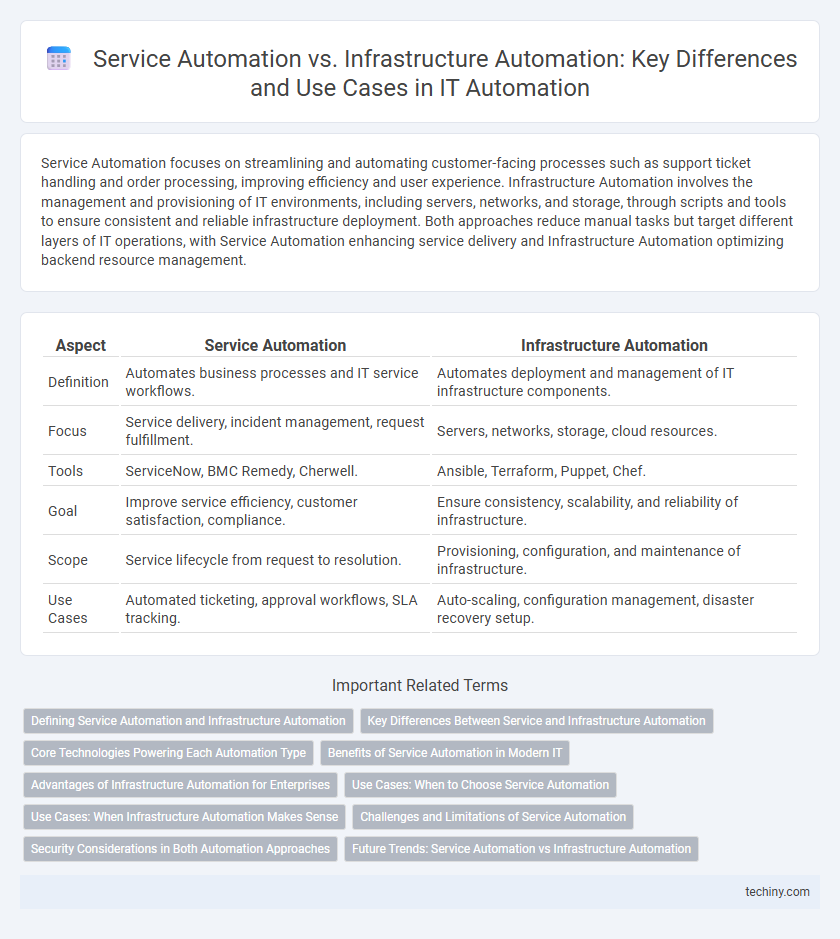Service Automation focuses on streamlining and automating customer-facing processes such as support ticket handling and order processing, improving efficiency and user experience. Infrastructure Automation involves the management and provisioning of IT environments, including servers, networks, and storage, through scripts and tools to ensure consistent and reliable infrastructure deployment. Both approaches reduce manual tasks but target different layers of IT operations, with Service Automation enhancing service delivery and Infrastructure Automation optimizing backend resource management.
Table of Comparison
| Aspect | Service Automation | Infrastructure Automation |
|---|---|---|
| Definition | Automates business processes and IT service workflows. | Automates deployment and management of IT infrastructure components. |
| Focus | Service delivery, incident management, request fulfillment. | Servers, networks, storage, cloud resources. |
| Tools | ServiceNow, BMC Remedy, Cherwell. | Ansible, Terraform, Puppet, Chef. |
| Goal | Improve service efficiency, customer satisfaction, compliance. | Ensure consistency, scalability, and reliability of infrastructure. |
| Scope | Service lifecycle from request to resolution. | Provisioning, configuration, and maintenance of infrastructure. |
| Use Cases | Automated ticketing, approval workflows, SLA tracking. | Auto-scaling, configuration management, disaster recovery setup. |
Defining Service Automation and Infrastructure Automation
Service Automation refers to the use of software and tools to automate customer-facing processes, such as ticketing, request fulfillment, and incident management, enhancing service delivery and user experience. Infrastructure Automation involves automating the provisioning, configuration, and management of IT resources like servers, networks, and storage, enabling scalable and consistent infrastructure deployment. Both types of automation leverage scripting, orchestration, and APIs to improve operational efficiency and reduce manual intervention.
Key Differences Between Service and Infrastructure Automation
Service automation focuses on streamlining end-user processes and business workflows by automating tasks like ticketing, approvals, and customer support interactions. Infrastructure automation targets the management and provisioning of IT resources such as servers, networks, and storage to ensure consistent and scalable environments. Key differences include the scope of automation--service automation enhances user experience and operational efficiency, while infrastructure automation guarantees reliable system availability and rapid deployment of hardware and software components.
Core Technologies Powering Each Automation Type
Service automation relies heavily on artificial intelligence (AI), machine learning (ML), and robotic process automation (RPA) to streamline customer interactions and business workflows. Infrastructure automation is powered by configuration management tools like Ansible, Puppet, and Terraform, enabling efficient provisioning, deployment, and management of IT resources. Both automation types benefit from APIs and cloud computing platforms to enhance scalability and integration.
Benefits of Service Automation in Modern IT
Service Automation enhances operational efficiency by streamlining an organization's workflows and accelerating service delivery, reducing human error and lowering operational costs. It enables proactive incident management and improves user experience through automated ticketing, self-service portals, and real-time service monitoring. By focusing on service-centric processes, Service Automation drives faster issue resolution and greater alignment with business objectives compared to Infrastructure Automation.
Advantages of Infrastructure Automation for Enterprises
Infrastructure automation streamlines the provisioning, configuration, and management of IT resources, enabling enterprises to achieve faster deployment times and reduced human error. This automation enhances scalability and resilience by ensuring consistent, repeatable processes across complex environments, which leads to improved system reliability and uptime. Enterprises benefit from cost savings due to optimized resource utilization and reduced operational overhead, accelerating digital transformation initiatives.
Use Cases: When to Choose Service Automation
Service Automation excels in use cases focused on improving customer interactions, such as automating ticketing systems, user request management, and incident resolution. It is ideal when the goal is to enhance service delivery speed and accuracy, reducing manual intervention in customer-facing processes. Choose Service Automation when your priority is streamlining workflows that directly impact end-users and service management.
Use Cases: When Infrastructure Automation Makes Sense
Infrastructure automation excels in scenarios requiring consistent deployment and scaling of servers, network configurations, and storage resources, such as cloud provisioning and disaster recovery. Use cases like automated patch management, configuration compliance, and infrastructure as code (IaC) highlight its efficiency in maintaining robust environments with minimal human intervention. Service automation is better suited for tasks involving user interactions and business workflows but lacks the deep control over hardware and environment setup that infrastructure automation provides.
Challenges and Limitations of Service Automation
Service automation faces challenges such as handling complex, variable customer interactions that require advanced AI and natural language processing capabilities. Limitations include difficulty in capturing nuanced human behavior and ensuring seamless integration with diverse service platforms, which can hinder scalability and adaptability. These constraints often result in lower accuracy and increased maintenance costs compared to infrastructure automation.
Security Considerations in Both Automation Approaches
Service automation enhances security by enforcing consistent access controls and automating threat detection within application workflows, reducing human error and response times. Infrastructure automation strengthens security through automated patch management, configuration compliance, and real-time monitoring of network components, minimizing vulnerabilities at the system level. Both approaches require integrated security policies and continuous auditing to ensure robust protection across all automated environments.
Future Trends: Service Automation vs Infrastructure Automation
Future trends in service automation emphasize intelligent process automation driven by AI and machine learning, enhancing customer interactions and operational efficiency. Infrastructure automation is evolving with the adoption of infrastructure as code (IaC), container orchestration, and edge computing to support scalable, resilient IT environments. The convergence of service and infrastructure automation fosters unified platforms that enable seamless orchestration, real-time analytics, and predictive maintenance across complex digital ecosystems.
Service Automation vs Infrastructure Automation Infographic

 techiny.com
techiny.com